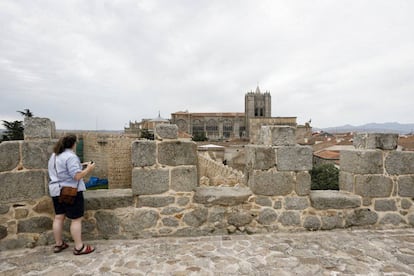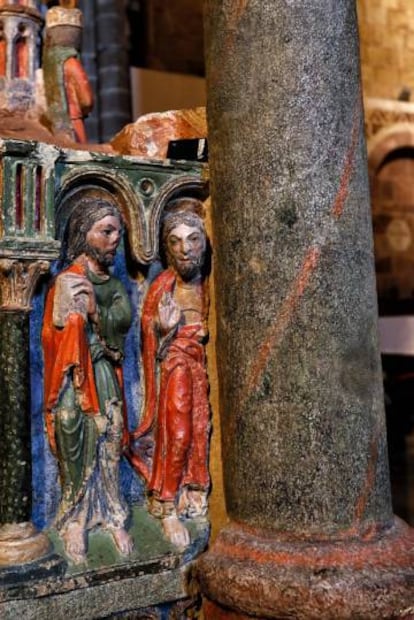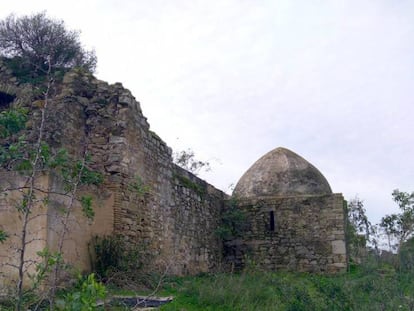How Big Data is being used to protect a Spanish UNESCO World Heritage site
Ávila is leading an EU project that uses technology to monitor potential damage to its famous walls
Twentieth-century Spanish novelist Azorín once described Ávila as “the most 16th-century of all Spanish cities,” generously endowed as it is with churches and palaces. Declared a World Heritage Site by UNESCO, it will now continue to live up to this boast in the 21st century by pioneering a European project called Smart Heritage City, aimed at monitoring this and other historical cities.

As many as 226 sensors are being installed along the city wall, around the cathedral and on important buildings and streets. These devices, more than half of which are already in action, pick up a huge amount of data concerning humidity, temperature, light, cracks, insects and traffic vibration. “New technology has to be applied to the conservation of monuments because they are very delicate,” says Rosa Ruiz, archaeologist and head of Ávila’s Heritage Department.
The sensors transmit information to a database and alert staff to the risk of damage on any stretch of wall
Tourism will also benefit from the initiative. According to the Ávila Tourism Board, the 400,000 visitors that visit the city every year will be better catered for. “It will provide us with information on the flow of visitors and their interests,” says Begoña García, from the Royal Santa María Foundation of Historical Heritage, who is in charge of the monitoring. “It will also aid energy efficiency as we will know where and when lighting is needed. And it should help prevent vandalism.”
The sensors can detect why the stonework on one of the facades of the Gothic cathedral is deteriorating and provide information on the humidity that adversely affects the 16th-century city wall, where 60 sensors have been installed. “The wall needs close monitoring,” says Ruiz. “We never allow a problem to go unattended.”

The size of a cigarette packet, the sensors transmit information to a database and alert staff to the risk of damage on any stretch of wall. “Soon, thanks to the accumulated data, we will be able to predict problems that might arise,” says García.
With a budget of €1.1 million, 75% of which comes from the European Union's regional development fund (FEDER), the project will be rolled out to other cities in Spain and across Europe.
The remaining 25% of the budget is being funded, among others, by the Faculty of Science and Technology at Nova University Lisbon and the French company Nobatek, which specializes in energy efficiency. Meanwhile, the Cartif Technology Center from Valladolid, Tecnalia from Bizkaia and Valencia's Aidimme Technology Institute are also involved.
Technicians from Aidimme are currently examining the upper reaches of the Palace of Los Superunda, which is a National Monument, to locate potential sources of humidity affecting the wood and have installed sensors to detect the presence of insects and fungus. “The device is a light that attracts xylophages [wood-eating insects] so we can detect their movement,” says researcher Miguel Ángel Abián. “We need to act before the damage is done,” explains Ruiz. “When xylophages attack they can’t be seen. You’re only aware of them once they have caused a certain amount of damage.”
Most of the sensors are hidden, but the device at the cenotaph in the Roman basilica of San Vicente can be seen. Like a silent watchman guarding the city, it sees that nothing disturbs it and nothing alarms it, as Ávila’s most revered resident, Saint Teresa, might have said.
English version by Heather Galloway.
Tu suscripción se está usando en otro dispositivo
¿Quieres añadir otro usuario a tu suscripción?
Si continúas leyendo en este dispositivo, no se podrá leer en el otro.
FlechaTu suscripción se está usando en otro dispositivo y solo puedes acceder a EL PAÍS desde un dispositivo a la vez.
Si quieres compartir tu cuenta, cambia tu suscripción a la modalidad Premium, así podrás añadir otro usuario. Cada uno accederá con su propia cuenta de email, lo que os permitirá personalizar vuestra experiencia en EL PAÍS.
¿Tienes una suscripción de empresa? Accede aquí para contratar más cuentas.
En el caso de no saber quién está usando tu cuenta, te recomendamos cambiar tu contraseña aquí.
Si decides continuar compartiendo tu cuenta, este mensaje se mostrará en tu dispositivo y en el de la otra persona que está usando tu cuenta de forma indefinida, afectando a tu experiencia de lectura. Puedes consultar aquí los términos y condiciones de la suscripción digital.
More information
Archived In
Últimas noticias
The complicated life of Francesca Albanese: A rising figure in Italy but barred from every bank by Trump’s sanctions
How Japan is trying to avert ‘digital defeat’
Reinhard Genzel, Nobel laureate in physics: ‘One-minute videos will never give you the truth’
Pinochet’s victims grapple with José Antonio Kast’s rise in Chile
Most viewed
- Pablo Escobar’s hippos: A serious environmental problem, 40 years on
- Why we lost the habit of sleeping in two segments and how that changed our sense of time
- Trump’s obsession with putting his name on everything is unprecedented in the United States
- The Florida Keys tourist paradise is besieged by immigration agents: ‘We’ve never seen anything like this’
- Charles Dubouloz, mountaineering star, retires at 36 with a farewell tour inspired by Walter Bonatti











































